Main menu
Common skin conditions

NEWS
Join DermNet PRO
Read more
Quick links
Authors: Vanessa Ngan, Staff Writer, Dr Amanda Oakley, Dermatologist, Hamilton, New Zealand. 1997. Updated December 2015. Revised by: Dr Abdulhadi Jfri, PGY-5 Dermatology Resident, Division of Dermatology, McGill University, Montreal, Quebec, Canada. Dr Elizabeth O’Brien, Assistant Professor of Dermatology, Division of Dermatology, McGill University, Montreal, Quebec, Canada. Copy edited by Gus Mitchell. January 2021. Minor amendment by Ian Coulson, Dermatologist. July 2024
" data-index="1" alt="Go to Introduction
" onclick="event.preventDefault();document.getElementsByTagName('h2')[(1 - 1)].scrollIntoView({behavior: 'smooth',block: 'start'});">Introduction
" data-index="2" alt="Go to Demographics
" onclick="event.preventDefault();document.getElementsByTagName('h2')[(2 - 1)].scrollIntoView({behavior: 'smooth',block: 'start'});">Demographics
" data-index="3" alt="Go to Causes
" onclick="event.preventDefault();document.getElementsByTagName('h2')[(3 - 1)].scrollIntoView({behavior: 'smooth',block: 'start'});">Causes
" data-index="4" alt="Go to Clinical features
" onclick="event.preventDefault();document.getElementsByTagName('h2')[(4 - 1)].scrollIntoView({behavior: 'smooth',block: 'start'});">Clinical features
" data-index="5" alt="Go to Assessment
" onclick="event.preventDefault();document.getElementsByTagName('h2')[(5 - 1)].scrollIntoView({behavior: 'smooth',block: 'start'});">Assessment
" data-index="6" alt="Go to Complications
" onclick="event.preventDefault();document.getElementsByTagName('h2')[(6 - 1)].scrollIntoView({behavior: 'smooth',block: 'start'});">Complications
" data-index="7" alt="Go to Diagnosis
" onclick="event.preventDefault();document.getElementsByTagName('h2')[(7 - 1)].scrollIntoView({behavior: 'smooth',block: 'start'});">Diagnosis
" data-index="8" alt="Go to Differential diagnoses
" onclick="event.preventDefault();document.getElementsByTagName('h2')[(8 - 1)].scrollIntoView({behavior: 'smooth',block: 'start'});">Differential diagnoses
" data-index="9" alt="Go to Treatment
" onclick="event.preventDefault();document.getElementsByTagName('h2')[(9 - 1)].scrollIntoView({behavior: 'smooth',block: 'start'});">Treatment
Outcome
See Management of hidradenitis suppurativa: an Australasian consensus statement
Hidradenitis suppurativa (HS), also called acne inversa, is a chronic inflammatory skin condition that affects apocrine gland-bearing skin in the axillae, groin, and under the breasts. It is characterised by persistent or recurrent boil-like nodules and abscesses that culminate in a purulent discharge, sinuses, and scarring.
HS can have a significant psychological impact, and many patients suffer from anxiety, depression, and impairment of body image.
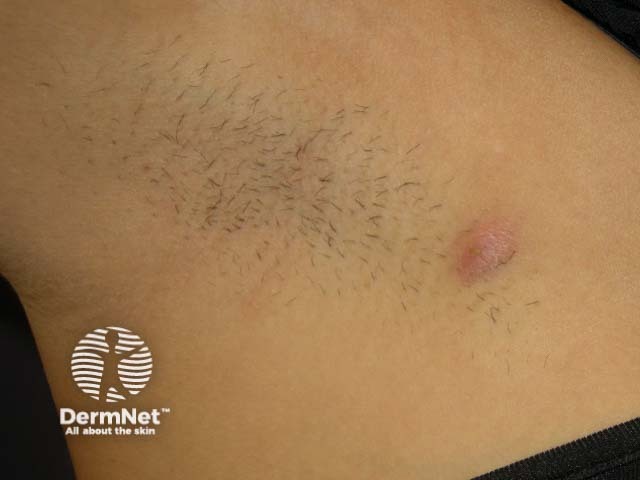
Hurley Stage I hidradenitis suppurativa

Hurley Stage II hidradenitis suppurativa
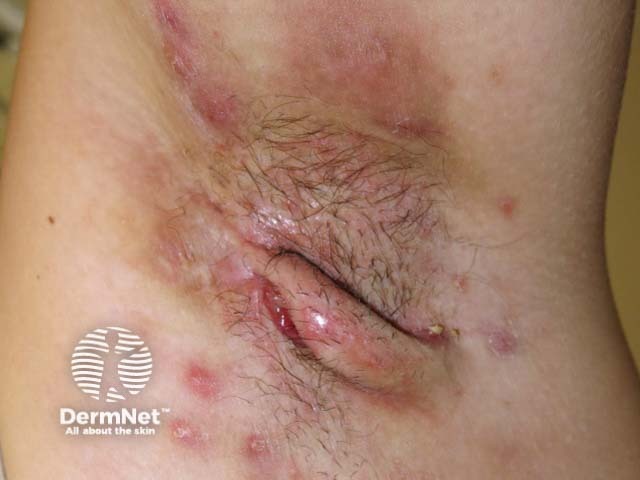
Hurley Stage III hidradenitis suppurativa
Hidradenitis suppurativa often starts at puberty, is most active between the ages of 20 and 40 years, and in women can resolve at menopause. It is three times more common in females than in males. Associations and risk factors include:
Although ‘hidradenitis’ implies an inflammatory disease of the sweat glands, we now know that HS is an autoinflammatory syndrome. The exact pathogenesis is not yet understood. Factors involved in the development of acne inversa include:
Acne inversa can affect single or multiple areas in the axillae, neck, inframammary fold, and inner upper thighs. Anogenital involvement most commonly affects the groin, mons pubis, vulva, scrotum, perineum, buttocks, and perianal folds.
HS is characterised clinically by:
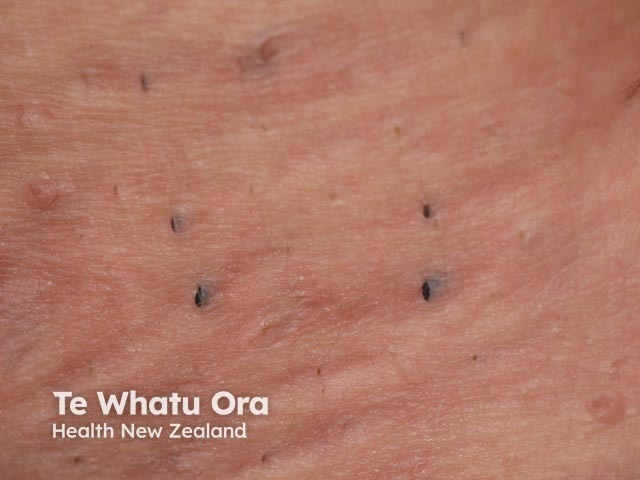
Comedones in hidradenitis suppurativa
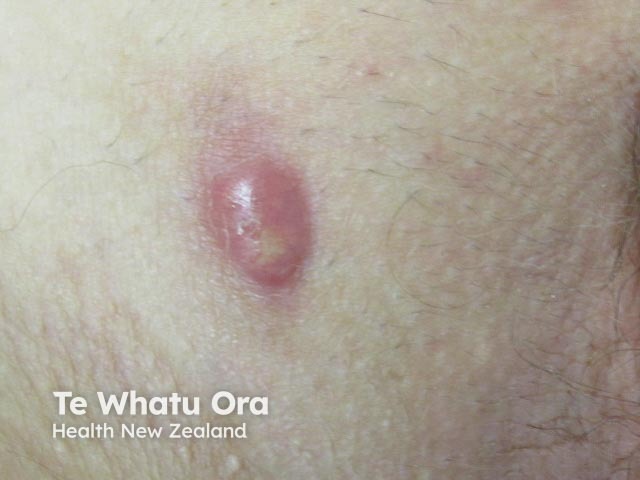
Inflammatory lesion in hidradenitis suppurativa

Scarring in hidradenitis suppurativa
Phenotype |
Clinical features |
Regular HS |
|
Frictional furuncle |
|
Scarring folliculitis |
|
Conglobata |
|
Syndromic |
|

Regular hidradenitis suppurativa
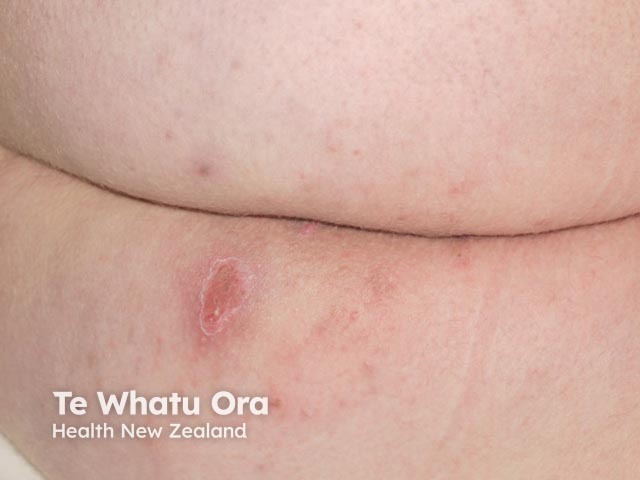
Frictional furuncle on the buttock

Scarring folliculitis
Disease severity and extent is measured by clinical and ultrasound assessment at the time of diagnosis and when monitoring response to treatment. There are a number of severity scales for HS [see guidelines for Hidradenitis suppurativa: severity assessment].
The Hurley system, the most widely used assessment tool, describes three clinical stages.
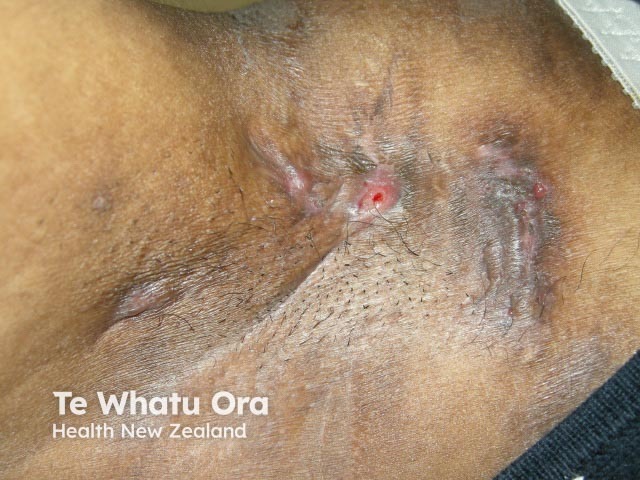
Hidradenitis suppurativa of axilla
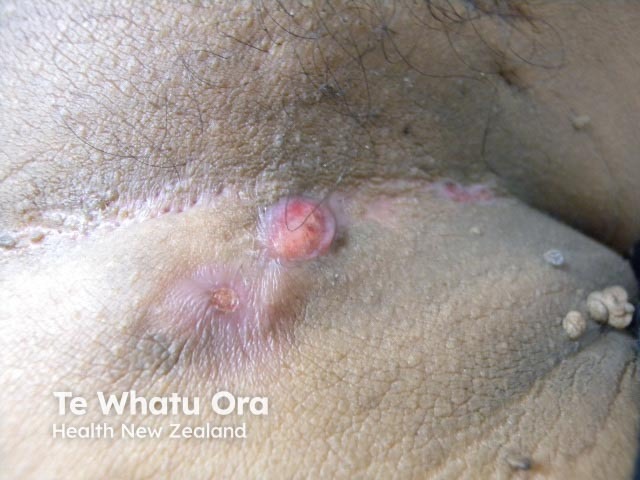
Hidradenitis suppurativa of groin
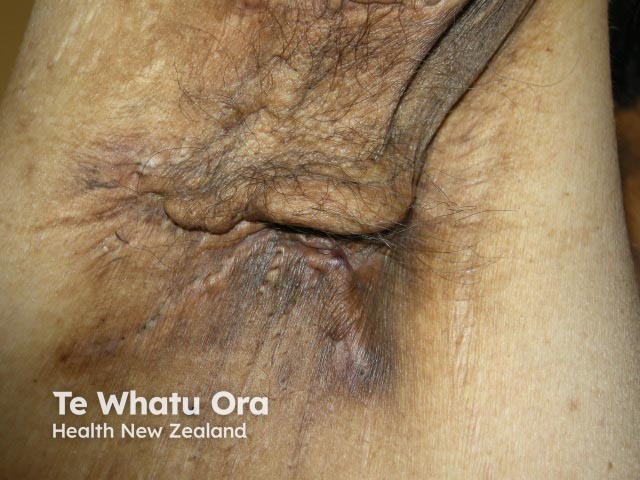
Hidradenitis suppurativa of axilla
Complications of HS can include:
The diagnosis of acne inversa requires all three components of the triad to be met:
Swabs for bacteriology are typically negative, which is a clue to diagnosis. Extensive investigations are rarely required. Investigations may be indicated to exclude a differential diagnosis, for possible complications, to identify comorbidities, or for planned treatment.
Differential diagnoses for hidradenitis suppurativa can include the following conditions.
For a detailed evidence-based review of treatment for HS, see Management of hidradenitis suppurativa: an Australasian consensus statement. The following provides important general measures and additional medical treatments.
General measures for treating patients with hidradenitis suppurativa include:
Specific medical measures for treating hidradenitis suppurativa include:
Antibiotics for bacterial infections
Other oral treatments
Surgical and other procedural measures
Hidradenitis suppurativa tends to improve in pregnancy in those who usually have flares during menstruation. Normal vaginal delivery is possible unless the patient has extensive painful genital lesions.
HS is a chronic scarring condition. Spontaneous remission may occur with time, but scarring persists.
Early diagnosis and treatment are required to minimise lasting damage.